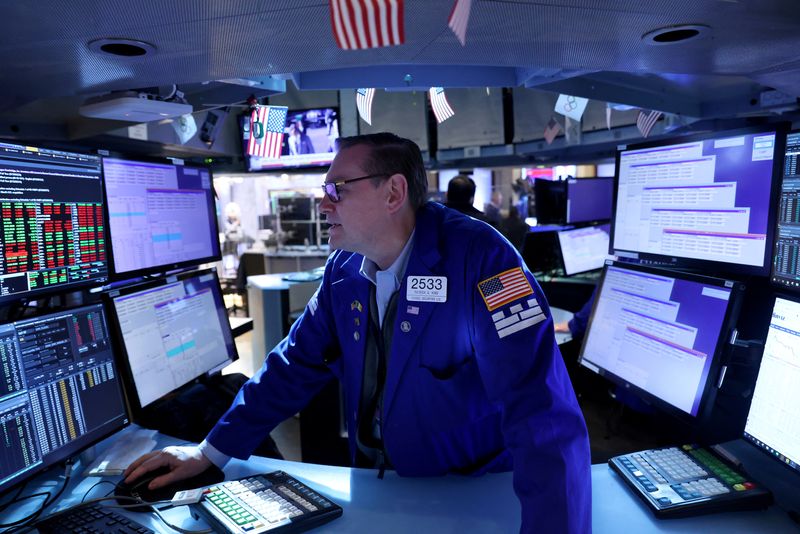By Lewis Krauskopf and Saikat Chatterjee
NEW YORK/LONDON (Reuters) -After a rocky week for U.S. stocks, a number of Wall Street strategists are pointing to reasons for further caution as investors face tightening monetary policy, corporate earnings, seasonal weakness and other factors that could spell more trouble for equities.
The S&P 500 was last down about 1% on Monday after posting its third straight weekly drop and has lost some 11% on a year-to-date basis. With the benchmark index approaching its closing low of 2022, several strategists have warned of more declines to come.
"A perfect storm of fears about inflation, the prospect of higher rates and a lockdown in Shanghai are weighing on sentiment," David Madden, market analyst at Equiti Capital, wrote in a note to investors.
Among those sounding caution was Morgan Stanley’s Michael Wilson, who in a report on Monday pointed to rising valuations for defensive stocks and slowing margin expansion as fresh warning signs for investors.
"With defensives the latest big outperformer, they are now expensive, leaving very few places to hide," Wilson and other Morgan Stanley (NYSE:MS) analysts wrote. "This suggests the S&P 500 will finally catch up to the average stock and enter a bear market."
"In our opinion, the accelerative price action on Thursday and Friday may also support the view we are now moving to this much broader sell-off phase," they wrote.
Meanwhile, Citi’s Matt King noted that reserves at the Federal Reserve fell by $460 billion last week, the single biggest weekly drop on record.
In a note titled "Sudden stealth QT = weaker markets", King estimates that a $100 billion drop in reserves translates to a 1% drop in stocks, referring to quantitative tightening, or the policy of central banks draining surplus cash from the markets, by its popular acronym.
Investors face a deluge of corporate earnings this week, including results from heavyweights such as Amazon.com (NASDAQ:AMZN), Apple (NASDAQ:AAPL) and Google parent Alphabet (NASDAQ:GOOGL), as well as continued geopolitical uncertainty stemming from the war in Ukraine and COVID-19 lockdowns in China.
Meanwhile, most investors expect the Fed to announce a half-percentage-point interest rate increase at the end of its policy meeting next week, though many worry that markets have not priced in the full scope of the U.S. central bank’s potential hawkishness, as policymakers battle the worst inflation in about 40 years.
"Markets have still not yet fully discounted the most likely future path" of Fed policy, Nicholas Colas, co-founder of DataTrek Research, said in a note on Monday.
"We continue to believe that US/global equities will not bottom until markets stop discounting ever more aggressive Fed rate policy," Colas wrote.
POSSIBLE REBOUND
World stocks recorded their worst quarter this year since the coronavirus pandemic unleashed havoc in March 2020.
To be sure, some see reasons for a bounce-back following the recent slide. JPMorgan (NYSE:JPM) strategists on Monday said they see "risks skewed toward a near-term equity rally," citing factors such as oversold conditions and systematic strategy buying.

At the same time, investors may have one more factor to worry about: seasonality.
The S&P 500's strongest six months of the year since 1946 have been November through April, when the index has risen an average of 6.8%, Sam Stovall, chief investment strategist at CFRA, said in a note on Monday. By comparison, the index has gained only 1.7% on average from May-October.
